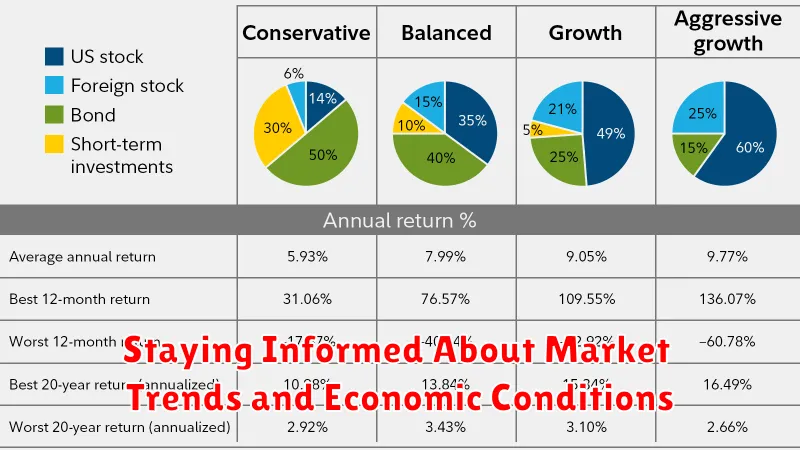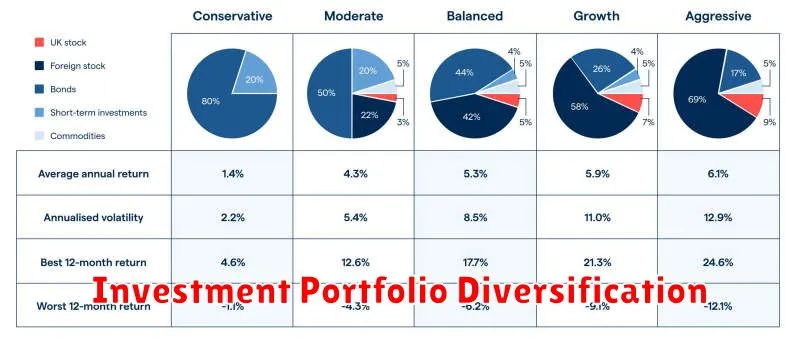Are you looking to secure your financial future and achieve your financial goals? Building an investment portfolio is a crucial step towards financial independence and wealth accumulation. Whether you’re a beginner with limited savings or a seasoned investor seeking to diversify your holdings, understanding the fundamentals of starting and growing an investment portfolio is essential.
In this comprehensive guide, we’ll delve into the core concepts of investment portfolio management. From determining your investment objectives and risk tolerance to selecting appropriate asset classes, we’ll provide you with the knowledge and tools to make informed investment decisions. Whether you’re interested in stocks, bonds, real estate, or other investment vehicles, we’ll explore the benefits and risks associated with each option. Let’s embark on a journey to navigate the world of investing and build a robust portfolio that aligns with your financial aspirations.
Defining Your Investment Goals and Risk Tolerance
Before you start investing, it’s crucial to define your investment goals and risk tolerance. This forms the foundation for building a portfolio that aligns with your financial aspirations and comfort level.
Investment goals are the specific financial objectives you want to achieve through investing. These could include:
- Retirement planning
- Saving for a down payment on a house
- Funding your child’s education
- Building an emergency fund
Each goal should have a clear time horizon – the timeframe in which you intend to achieve it. For instance, retirement savings might have a long time horizon, while a down payment on a house could have a shorter timeframe.
Risk tolerance refers to your ability and willingness to accept potential losses in pursuit of higher returns. It’s influenced by factors like your age, income, financial situation, and investment experience.
To determine your risk tolerance, consider your comfort level with potential market fluctuations. A high-risk tolerance means you are willing to accept greater volatility in exchange for the potential for higher returns. Conversely, a low-risk tolerance indicates a preference for investments with lower risk and potentially lower returns.
Understanding your investment goals and risk tolerance is essential for choosing appropriate investments. By aligning your portfolio with your goals and comfort level, you can increase your chances of achieving financial success over the long term.
Understanding Different Asset Classes and Their Characteristics
An investment portfolio is a collection of different assets that you own. These assets can include anything from stocks and bonds to real estate and commodities. Each asset class has its own unique characteristics, including its potential for growth, risk, and liquidity. It’s essential to understand these characteristics when constructing a well-balanced portfolio.
Stocks
Stocks represent ownership in a company. When you buy a stock, you’re buying a small piece of that company. Stocks are considered to be a high-growth asset class, but they are also considered to be high-risk. This means that they have the potential to grow in value significantly, but they can also lose value just as quickly.
Bonds
Bonds are debt securities that represent a loan made by an investor to a borrower. When you buy a bond, you are lending money to the borrower in exchange for a fixed rate of interest. Bonds are generally considered to be less risky than stocks, but they also have lower growth potential.
Real Estate
Real estate includes properties such as land, buildings, and homes. It can be an investment in itself, or it can be used to generate rental income. Real estate is generally considered to be a relatively stable asset class, but it can be illiquid, meaning it can be difficult to sell quickly.
Commodities
Commodities are raw materials that are traded on exchanges. Examples include gold, oil, and agricultural products. Commodities can be volatile, but they can also be a good way to hedge against inflation.
Cash
Cash is the most liquid asset class and is often used for short-term needs and emergency funds. While it generally has a low return, it provides safety and liquidity.
By understanding the characteristics of different asset classes, you can build a portfolio that meets your individual risk tolerance and financial goals. It’s crucial to diversify your portfolio across different asset classes to manage risk and optimize returns.
Choosing the Right Investment Accounts (Taxable, Retirement, etc.)
Once you’ve decided to start investing, you’ll need to choose the right type of account. There are a few different types of investment accounts, each with its own advantages and disadvantages. Here’s a brief overview of the most common types:
Taxable brokerage accounts allow you to invest in a wide range of assets, including stocks, bonds, mutual funds, and exchange-traded funds (ETFs). The main disadvantage of taxable accounts is that you’ll have to pay taxes on any capital gains or dividends you earn.
Retirement accounts are designed to help you save for retirement. The most common types of retirement accounts are traditional IRAs, Roth IRAs, 401(k)s, and 403(b)s. Retirement accounts offer tax advantages, such as tax-deferred growth or tax-free withdrawals in retirement. The specific rules and regulations vary depending on the type of account.
529 plans are specifically designed to save for education expenses. These accounts offer tax advantages for both contributions and withdrawals. The money can be used to pay for college, graduate school, or even vocational training.
The best type of account for you will depend on your individual circumstances and goals. For example, if you’re saving for retirement, a retirement account is likely the best option. If you’re looking for a more flexible investment vehicle, a taxable brokerage account may be a better choice. It’s always a good idea to speak with a financial advisor to determine the best investment strategy for your specific situation.
Determining Your Asset Allocation Strategy
Asset allocation is the process of dividing your investment portfolio among different asset classes, such as stocks, bonds, real estate, and cash. This strategy aims to diversify your portfolio and reduce risk. It is crucial to determine your asset allocation strategy before you begin investing, as it will influence your returns and overall financial goals.
The first step in determining your asset allocation is to understand your risk tolerance. This refers to your ability and willingness to stomach potential losses in exchange for the possibility of higher returns. Consider factors like your age, financial situation, and investment goals.
Once you have a sense of your risk tolerance, you can consider your investment time horizon. The time you have to reach your investment goals will influence how much risk you can take. For instance, if you are investing for retirement, you might have a longer time horizon and can potentially take on more risk than someone investing for a short-term goal, like a down payment on a house.
Lastly, consider your investment goals. What do you hope to achieve with your investments? Are you saving for retirement, a down payment on a house, or your child’s education? Your goals will determine the types of assets you choose and the investment strategy you follow.
Once you’ve considered these factors, you can start allocating your assets. You can do this through a variety of methods, including consulting a financial advisor or using online tools. The ideal asset allocation will depend on your individual circumstances. But, by understanding the basics of asset allocation, you can develop a strategy that aligns with your financial goals and risk tolerance.
Researching and Selecting Individual Investments
Once you have a solid understanding of your investment goals, risk tolerance, and time horizon, it’s time to start researching and selecting individual investments. There are a wide variety of investment options available, so it’s important to do your due diligence before making any decisions.
A good starting point is to consider different asset classes, such as stocks, bonds, real estate, and commodities. Each asset class has its own unique characteristics, risks, and potential rewards. Stocks, for instance, are considered a more volatile investment than bonds but have the potential for higher returns over the long term. Bonds, on the other hand, are generally considered less risky than stocks and are often used for income generation.
Once you’ve identified asset classes that align with your investment goals, you can start researching specific investments within those classes. This research should include factors like the company’s financial health, management team, and competitive landscape. You can find this information through online sources such as company websites, financial news websites, and investment research firms.
It’s also important to consider your investment strategy when selecting individual investments. For example, if you’re a long-term investor, you may want to focus on companies with a strong track record of growth and profitability. If you’re a short-term trader, you may want to look for companies that are likely to experience a sudden price jump in the near future.
Remember that there’s no one-size-fits-all approach to investing. What works for one person may not work for another. The key is to find an approach that you understand and are comfortable with.
Diversifying Your Portfolio to Manage Risk
Diversification is a key principle in investing that aims to reduce risk by spreading your investments across different asset classes, sectors, and geographies. Instead of putting all your eggs in one basket, diversification helps mitigate potential losses if one particular investment performs poorly.
Asset allocation plays a crucial role in diversification. By allocating your capital strategically across different asset classes like stocks, bonds, real estate, and commodities, you can create a balanced portfolio that can weather market fluctuations. For instance, stocks tend to be riskier but offer higher potential returns, while bonds provide more stability but may generate lower returns.
Sector diversification involves investing in companies operating in different industries. This strategy helps mitigate risks associated with specific sectors. If one industry experiences a downturn, your portfolio might still perform well due to investments in other sectors.
Geographic diversification extends beyond national borders, investing in companies and assets across the globe. This approach helps to reduce risk associated with specific economic or political events in one region.
Remember, diversification doesn’t guarantee profits, but it can significantly reduce your overall portfolio risk. Consider your risk tolerance and investment goals when designing your diversified portfolio. Consulting with a financial advisor can provide valuable insights and support in building a well-diversified investment strategy.
Investing Regularly and Consistently
One of the most important principles of investing is to invest regularly and consistently. This is known as dollar-cost averaging, and it involves investing a fixed amount of money at regular intervals, regardless of market conditions.
Dollar-cost averaging helps to mitigate the risk of market volatility. When you invest regularly, you buy more shares when prices are low and fewer shares when prices are high. This averages out your purchase price over time, reducing the impact of short-term market fluctuations.
Investing consistently also helps to build discipline and develop a long-term investment mindset. By making regular contributions, you are automatically saving and investing, even when the market is not doing well.
There are several ways to invest regularly, such as setting up automatic contributions to your investment accounts or using a robo-advisor. It’s important to choose a strategy that fits your financial goals and risk tolerance.
Regular and consistent investing is a powerful strategy for building wealth over time. It helps to reduce risk, build discipline, and create a long-term investment habit.
Rebalancing Your Portfolio to Maintain Your Target Allocation
Rebalancing is an important aspect of managing your investment portfolio. It involves adjusting your asset allocation to bring it back in line with your original target percentages. This process helps to ensure that your portfolio stays on track and achieves your long-term financial goals.
Your asset allocation is the mix of different investments in your portfolio, such as stocks, bonds, and cash. As your investments grow at different rates, your asset allocation can drift from your initial target. Rebalancing helps to correct this drift and maintain your desired risk and return profile.
Why Rebalance?
- Maintain Your Risk Tolerance: Rebalancing ensures your portfolio stays aligned with your risk tolerance. If a particular asset class outperforms, it can become too large a portion of your portfolio, increasing your overall risk.
- Capitalize on Market Volatility: When markets are volatile, rebalancing allows you to buy low and sell high, potentially boosting your returns. For instance, if stocks have declined, rebalancing might involve selling some of your bonds to buy more stocks, taking advantage of the lower prices.
- Stay Disciplined: Rebalancing helps you remain disciplined in your investment strategy and avoids emotional decision-making driven by short-term market fluctuations.
How to Rebalance:
Rebalancing is a simple process. You can rebalance your portfolio periodically, such as quarterly or annually. The frequency depends on your tolerance for risk and how much your asset allocation tends to drift. To rebalance, determine the current percentage of each asset class in your portfolio. Compare these percentages to your target allocation, and adjust your holdings accordingly. This might involve selling assets that have outperformed and buying more of those that have underperformed.
Important Notes:
Rebalancing should be a regular practice. Don’t wait until your asset allocation deviates significantly from your target. Consult with a financial advisor if you need assistance in developing an appropriate rebalancing strategy. Remember, rebalancing is an ongoing process, and it’s essential to review and adjust your portfolio’s asset allocation regularly.
Monitoring Your Investments and Making Adjustments as Needed
Once you’ve built your initial investment portfolio, it’s crucial to regularly monitor its performance and make adjustments as needed. This involves tracking the performance of your investments, evaluating your overall portfolio allocation, and considering any changes in your financial goals or risk tolerance.
Tracking performance involves looking at the returns of your investments over time, such as stock prices, interest rates, or dividend payments. You can use online brokerage accounts, financial websites, or spreadsheets to track this data. It’s essential to understand how your investments are performing relative to their benchmarks and your overall financial goals.
Portfolio allocation refers to the distribution of your assets across different investment categories, like stocks, bonds, real estate, and cash. As your investments grow and your financial situation changes, you may need to rebalance your portfolio to maintain your desired asset allocation. This ensures that your investments are aligned with your risk tolerance and financial goals.
Adjusting your investments can involve buying or selling assets, changing your investment strategy, or seeking professional advice. This could be due to market conditions, changes in your personal circumstances, or new investment opportunities. It’s crucial to be proactive and make adjustments to your portfolio as needed to ensure it remains aligned with your financial goals.
Regular monitoring and adjustments are essential for long-term investment success. By staying informed and making strategic decisions, you can improve your chances of achieving your investment goals and building a strong financial future.
Staying Informed About Market Trends and Economic Conditions

Staying informed about market trends and economic conditions is crucial for making sound investment decisions. By understanding the current economic climate and market behavior, you can make more informed choices about where to allocate your capital. This involves monitoring key economic indicators such as inflation, interest rates, employment data, and consumer sentiment.
Analyzing these indicators helps you anticipate potential market movements and adjust your investment strategy accordingly. For instance, rising interest rates may impact bond prices, while economic growth can drive stock market performance. You can utilize various resources to stay informed, including financial news websites, economic research reports, and investment newsletters.
Additionally, consider subscribing to the services of reputable financial advisors who can provide valuable insights and guidance. By staying informed, you can make more confident investment decisions and navigate the complexities of the market with greater clarity.
Seeking Professional Advice from a Qualified Financial Advisor

While many investors prefer to manage their portfolios themselves, there are significant benefits to seeking professional advice from a qualified financial advisor. A financial advisor can provide valuable insights and guidance based on your individual financial circumstances, risk tolerance, and investment goals. They have a deep understanding of the financial markets and can navigate the complexities of investing, helping you make informed decisions.
A financial advisor can help you with various aspects of portfolio management, including:
- Developing a personalized investment strategy tailored to your unique needs and objectives.
- Choosing the right investment vehicles, such as stocks, bonds, mutual funds, or exchange-traded funds (ETFs), based on your risk profile and time horizon.
- Diversifying your portfolio across different asset classes to mitigate risk.
- Monitoring and adjusting your investments periodically to ensure they remain aligned with your goals.
- Providing financial planning services, such as retirement planning, college savings, and estate planning.
It is essential to find a financial advisor who is qualified, experienced, and has a fiduciary responsibility to act in your best interests. You can seek recommendations from trusted sources, such as friends, family, or colleagues, or use online tools to find reputable advisors in your area. When choosing an advisor, consider their qualifications, experience, fees, and communication style.
Consulting a financial advisor can be a wise decision, especially for those new to investing or who lack the time or expertise to manage their portfolios effectively. A professional advisor can provide invaluable guidance, support, and peace of mind, helping you achieve your financial goals with greater confidence.

